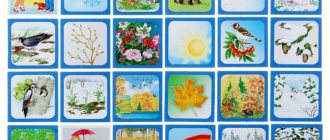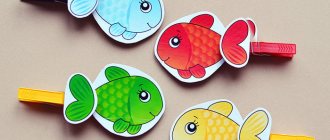Development of fine motor skills in children 4-5 years old
Master class “Development of fine motor skills of hands in children of middle preschool age”
Rasskazenkova Olga Nikolaevna Educator Municipal state-owned preschool educational institution “Kindergarten No. 27” Dear colleagues, today I want to share with you my experience in using didactic games to develop fine motor skills in middle-aged children, which can be done both in kindergarten and Houses.
(Fine motor skills are a set of coordinated actions aimed at accurately performing small movements with the fingers and hands and feet. The nervous, muscular, skeletal and even visual systems take part in this. It includes a variety of movements: from all the usual gestures to the smallest manipulations. ) an important factor in the success of a child’s intellectual and psychophysical development. At all stages of a child's life, hand movements are very important. The most favorable period for the development of a person’s intellectual and creative capabilities is from 3 to 9 years, when the cerebral cortex has not yet been fully formed. It is at this age that it is necessary to develop memory, perception, thinking, attention. (“The origins of children’s abilities and talents are at the tips of their fingers. From the fingers, figuratively speaking, come the finest streams that feed the source of creative thought.” V.A. Sukhomlinsky) The development of fine motor skills is important because the child’s entire future life will require the use precise, coordinated movements of the hands and fingers, which are necessary to dress, draw, write, and also perform a wide variety of everyday and educational activities. The development of manual skill and fine motor skills is also important for the personal development of the child himself. By owning a hand, a child in the process of his development becomes more independent, autonomous and independent from an adult, which contributes to the development of his initiative in various types of children's activities. According to the Federal State Educational Standard for Preschool Education, among the target guidelines at the stage of completing preschool education, it is noted that the child shows initiative and independence in various types of activities - play, communication, the child has developed fine motor skills; he can control and manipulate his movements. A consequence of poor development of fine motor skills of the hand is the general unpreparedness of most children for writing or a problem with speech development. Children with poorly developed manual motor skills awkwardly hold a spoon or pencil, cannot fasten buttons, or lace up shoes. It can be difficult for them to collect scattered parts of the construction set, to work with puzzles, counting sticks, and mosaics. The Federal State Educational Standard for Education tells us that the development of a child should occur in “forms specific to the development of a given age group, primarily in the form of a game,” which is why in my work I use didactic games that allow me to actively develop the fine motor skills of the children in my group. There are many such games, I want to present those that we made together with our parents. Organizational point: we may not know each other well, but I hope we will understand each other, and games will help us with this, we will take them with us. Look what a beautiful bunch of grapes I have, I’ll now tear off one berry from it and tell you my name - my name is Olga Nikolaevna. Pass the bunch on, each “berry” says its name.
Well, here we are. A bunch of grapes consists of different berries, and we are all different. The berries are on a branch together, holding on tightly to it, so we will play games together and exchange work experience. Take the hands of the one sitting next to you, feel the warmth of the hands of your colleagues, who will be your good helpers. With the help of the organizational moment, I create a favorable atmosphere for the upcoming activity, which from the first minutes promises to be exciting, unusual and interesting. I suggest going on a tour of the autumn park. And to keep us warm, we need to put on a coat (hand out coat templates and offer to fasten the buttons). While working, read a poem: the buttons on Verochka’s coat are harmful, the girl’s poor fingers are suffering. The buttons seem to mock Vera, jumping like squirrels, breaking off the threads. Angry tears are rolling down, your brow is frowning sternly, shouldn’t you wear a dress outside in the fall?
With children, you can make playing with buttons exciting, during which you can set various didactic tasks: developing fine motor skills, eye, concentration, perseverance, consolidating knowledge of colors, size, learning to count. One, two, three, four, five - we continue to play, so that our hands do not freeze, we need to warm our hands (game “Hands with elastic bands”). Take two models each and complete the task according to the sample. While working, read the poem: Masha put on her mitten, oh, where am I going? The finger is missing, it’s gone, it didn’t make it to my little house. Masha took off her mitten - hello, little finger, how are you? (play with your fingers). Children love such games very much, they develop thinking, attention, speech, because children can repeat the poem together with the teacher.
My daughter has boots, they are as good as in the picture, but one of all the problems is that my daughter doesn’t like them at all. She doesn’t like laces, they are difficult to deal with (hand out the game “Lacing Shoes”). It’s terrible how much flour it takes to lace up 2 pieces! Slippery, stubborn, mischievous ones. Then the laces came to their senses and were stuck into the holes.
This game can keep your child busy for a long time. What seems so simple and uninteresting to us adults captivates the child and, at the same time, develops his motor skills. This exercise is especially good for training finger coordination. It requires extreme concentration and contributes to the accuracy of the eye. We are dressed and wearing shoes, we can go out for a walk - I suggest collecting a bouquet of leaves for mom (game “Autumn Bouquet”). We will collect birch leaves, rowan leaves, poplar leaves, aspen leaves, oak leaves and take an autumn bouquet to mom. “Autumn Bouquet” is another one of children’s favorite games, with its help we develop fine motor skills, imagination, attention, coordination of movements, speech, and consolidate form. It can be transformed into the games “Which tree is the leaf from”, “Run to the tree”.
We were walking around the park and watching everyone, suddenly, out of nowhere, mice came running (hand out templates, offer to make the mice eyes, nose, ear and braid the tail).
At this time, perform physical. a moment with the jury members. First, let’s warm up our fingers (rubbing the pencil on our palms), exercise “Crane” - we lift the pencil, press it firmly with our finger, “Iron” - I will swing the pencil, from left to right as I want. Such games with a pencil can be played with children while working in notebooks, and recommended to parents for individual work at home. Make paws for your mouse: the mouse was in a hurry to visit and got ready for the journey (your mice ran), the mice stole the cheese, threw a feast in the hole (play with the cheese). Everything is upside down, burrum-burum, gnawing-gnawing-gnawing and crunch, crunch, crunch. There are many variations of this game; it improves coordination between the eyes and hands, and coordination of movements. Weaving influences the development of accuracy, patience, perseverance, the desire to overcome difficulties, to complete the work started, gradually controlling one’s actions. You can take this game with you and play with your children. Our journey into the forest has ended. Look at the sun, stretch out your hands towards it. Its rays, like a mother’s tender hands, warm us with their warmth, we want to laugh, rejoicing at the new day. If you liked everything, and you will use games in your work, I ask you to give a ray of sunshine.
I use this game as a reflection at the end of the activity. You can not only attach rays, but also decorate the rays with ribbons, which contributes to the development of manual dexterity, movements of the hand and fingers, skill, and accuracy. I would like to end our master class with the words of the philosopher Emmanuel Kant - “The hand is a kind of external brain!” This means that at the tips of the fingers there are nerve endings that contribute to the transmission of a huge number of signals to the brain center, and this affects the development of the child as a whole. I will be glad if you use these games in your work. All I can do is thank you for your attention, it was a pleasure working with you. I wish you all creative success.
We recommend watching:
Didactic game for preschoolers to develop fine motor skills Development of fine motor skills using the isothread technique Layouts for kindergarten. Russian folk tales Development of fine motor skills in children of primary preschool age
Similar articles:
Work in a corner of nature in the middle group
Poems for children in the middle group of kindergarten
Thematic Game Day in the middle group of preschool educational institutions
Thematic days in kindergarten in the middle group
Thematic days in the senior group in winter
From 8 months: inserts
- Cups, jars, bowls, nesting dolls, children's toy dishes. Any household items (safe for the child), varying in size, which the baby will endlessly “test for compatibility”: assemble, disassemble, insert, lay out, knock them against each other. “I’m developing fine motor skills, mom, be patient!” Can be offered to a sitting child from 6 months.
- Boxes, jars with lids, bags - the baby learns to open and close.
- Sorters (boxes with slots of different configurations and elements of the appropriate size and shape). Wooden, plastic, round, square, in the shape of dogs or boats - whatever you like. They usually become a favorite pastime no earlier than 8–9 months. You can do without a purchased toy. A clean shoe box made of thick cardboard, windows cut out with scissors and objects of appropriate shape (large buttons and beads, cubes, etc.) - the baby will be busy with them for a long time. You'll even have time to wash your hair or drink your morning coffee (we can't promise everything at once!).
- Twisting and unwinding. Caps, lids, toy screws - everything that can be screwed on or turned in one direction or the other. It is not necessary to buy special sets - just offer your baby a plastic bottle with a lid or a plastic thermos.
- Wooden cubes, pyramids, abacus, knockers with hammers, construction sets, simple musical toys, insert frames. They satisfy the baby's cognitive interest, develop spatial orientation and - what is most important for us now - improve small hand movements, develop coordination and dexterity.
From 1 year: natural materials
- Sand games: buckets, molds, shovel, Easter cakes. A lesson for several seasons. At first, your mother (grandmother, nanny) will make the molds. We recommend starting with large molds: with their help you can make even shapes without crumbling edges (any “imperfection” can make kids angry; they strive for ideals in everything).
- Plasticine, plastic clay, salt dough. We roll sausages, make koloboks, strings and glue them into a hoop. Such activities perfectly strengthen the muscles of the hand, make the fingers more dexterous and mobile, and expand the child’s ideas about his capabilities. At a later age, your child will proudly bring figurines of hedgehogs, bunnies and dogs from kindergarten classes, which will begin to settle on your bookshelves. You cannot treat them with disrespect - these are the first products of a child’s labor, he values them very much!
- Cones, pebbles, sand, pebbles, walnuts (in shell) and chestnuts. The latter are collected during a walk in the fall, stuffed into pockets, brought home and washed. Now it’s useful to knead them in your palms, two at a time, and rotate one around the other.
- Games with any bulk materials. The child puts his hands into a vessel with some homogeneous filler (sand, various grains, pellets, any small objects). Stirs the contents for a few minutes. Then he is offered a vessel with a filler of a different texture. After several trials, the child, with his eyes closed, puts his hand into the offered vessel and tries to guess its contents without feeling its individual elements with his fingers. At the same time we develop speech. Do this only under the supervision of an adult: small objects are not recommended for children under 3 years of age to play with.
Invite your child to play “Cinderella” - sort beans, peas, large beads, dry pasta of different colors into different containers.






